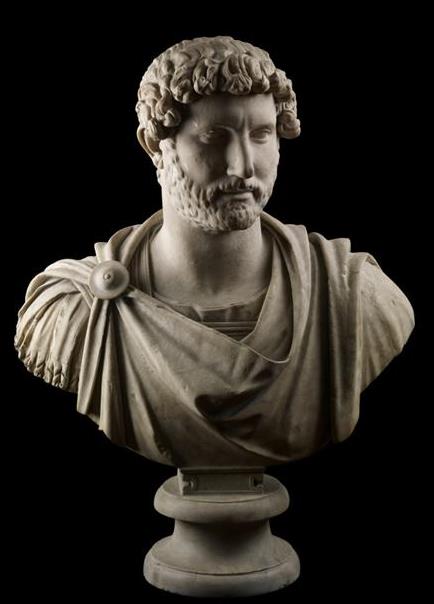Bust of Hadrian, 118-130 CE
Bust of Hadrian
Hadrian, Roman emperor from 117 CE to 138 CE, ruthlessly quashed the Bar Kokba Revolt and resettled Jerusalem as Aelia Capitolina.
This bust is was found at the Villa Adriana, the Roman emperor Hadrian’s magnificent country residence near Tivoli, outside Rome.
In ancient Rome, the dedication of public statues was governed by rules concerning location, material and iconography. This was even more important when it concerned imperial images. Official portraits were an extremely important way for Roman emperors to reach out to their subjects and their public image was defined by them.
There are hundreds of surviving imperial statues, which show us that there were only three ways in which the emperor could officially be represented- in the battle dress of a general; in a toga, the Roman state civilian costume; or nude, likened to a god. These formats powerfully and effectively evoked the emperor’s role as commander-in-chief, magistrate or priest, and finally as the ultimate embodiment of divine providence.
We know from ancient literary sources that Hadrian was particularly keen to project a strong military image and in this bust we see Hadrian presented as the commander-in-chief.
British Museum- Marble bust of the emperor Hadrian wearing military dress
See also-
- Statue of Hadrian, 135 CE
- Coin of Hadrian, c. 132-134 CE
- Bronze Head of Hadrian, c. 122 CE
- Hadrian’s Wall, 122 CE
- Hadrian’s Mausoleum, 135-139 CE
- “Rare Bronze Statue of Hadrian Found by Tourist,” Suzanne F. Singer, BAR 2-04, Dec 1976.
- Werner Eck. “Hadrian’s Hard-Won Victory- Romans Suffer Severe Losses in Jewish War.” Biblical Archaeology Review 33, 5 (2007).
- Kenneth G. Holum. “Iter Principis- Hadrian’s Imperial Tour.” Biblical Archaeology Review 23, 6 (1997).
- Bronze Bust of Hadrian, ruled 117-138, Roman emperor who instigated the Bar Kokhba Revolt.
- Rebellion against Roman Rule, Rina Abrams, COJS.
- Map of the Roman Empire in the Time of Hadrian




